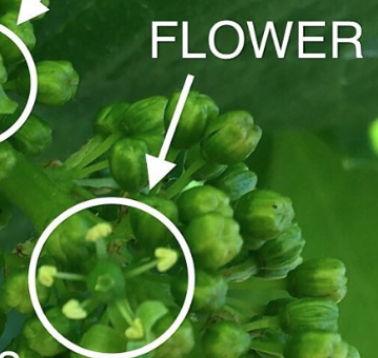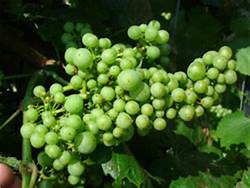Welcome to the blog where you will find musings from around the vineyard and winery. News from the founder Andrew Hodson, a glimpse from the cellar and more.
ANDREW'S NEWSLETTER
VINIFICATION
EVENTS AT VERITAS
Browse by Category
Experience Veritas
Weddings at Veritas
Shop Wines
A Day in the Life of a Vine – Flowering
May 26, 2021
Efflorescence, or simply flowering, of the vines is one of the most sensitive and crucial periods in the life of a vine.
If you remember in my last post I talked about crucial times in the life of a vine. At that time it was all about bud break when the dormant bud on the canes breaks forth with leaves and flower buds.

The initial inflorescence (the flower bud) contains hundreds of flowers but not all flowers will turn into berries. Depending on weather conditions a large number of flowers simply fail to get pollinated. As a general rule one flower equals one berry. Now and for the next couple of weeks the flowers will start emerging.

Before each flower opens up there is a little cap on top of each flower that in some cases one can see still stuck on the end of the grape berry. The cap falls off and a single flower emerges.


The actual flower consists of a central ovary that is destined to become the grape berry and usually 5-6 anthers that look like petals to the unaccustomed eye. Anthers produce the pollen that falls onto and fertilizes the ovary to create the grape berry.
Pollination of the Vines
One of the very interesting facts about the European grapes we choose to grow (vitis vinifera) is that the vines are hermaphroditic. This means that the flowers have both male and female components and most importantly are able to self-pollinate. Other species of vines, for example North American (vitis labrusca and vitis aestivalis) vines, are either male or female and pollination requires the intervention of a third party, most typically a bee or some form of insect.
Although vinifera vines do not need insects to pollinate them, there are good studies to show in organic and biodynamic vineyards that pollination and fruit set markedly increases in the presence of a healthy insect population. It appears on the face of it that it should be a pretty straightforward process, but as with everything Mother Nature does when it comes to sexual reproduction – it’s not that simple.
You see it all depends!
In order for that simple process to occur vines need two things at the time of flowering, warmth and sunlight. Here, just like with bud break, timing is everything. If it is cold and wet during this time, pollination will fail to occur and berries fail to form.
Flowering to Fruit Set
The industry calls this period of time “fruit set”. The weather conditions during fruit set determine not only the amount of the crop but also the quality of the crop. If the weather is sunny and dry many more flowers get pollinated and more berries form. When there is cloud cover, wind, and rain the flowers can fail to pollinate that winegrowers refer to as “shatter.” The French have their own term, “coulure” that describes a flow of flowers from the stem that failed to pollinate.




Importance of Uniformity
If you think about tannins in red wines, uniformity of fruit ripening is crucial to making good wine. Because if the tannins are at different stages of ripeness, young green tannins clash with more mature tannins and the result will be an unbalanced, poor quality wine.
You see at every critical stage of grape vine development – bud break, fruit set, and yet to come veraison and pre-harvest ripening, we are at the mercy of that lazy old sun who rolls around in heaven all day.
However, it is not just the total amount of sun, it is the timing of the sun. A good example is the 2018 growing season and harvest. We had more growing degree days, but during efflorescence and at the end of harvest the sun did not shine. This resulted in poor fruit yield and fruit quality. In contrast, in 2017 we had fewer growing degree days, but at efflorescence and at harvest the sun was shining and we had a beautiful crop that yielded a ton of beautiful wines.
Remember the wine is made in the vineyard.
Growing grapes to make wine is not like growing grapes to put on the table; it is almost the reverse. If you are a grape grower, obviously the more fruit you produce the more money you make. In wine grape growing, the less fruit a vine produces, the better it is for the quality of the wine. But people pay for quality not quantity and therein lies the rub!
Keep tuned to the life cycle of the vine as the grapes grow during the different seasons so you can appreciate the almost infinite number of variables that go into that bottle of your favorite Veritas wine.
Thanks for reading, have a great Memorial Day.
Andrew Hodson
Thanks for this information! And how are we doing this year? I think I’m not liking the cloud cover…
This is fascinating!! Thank you!!
Hi Lisa,
Actually we have had enough sunlight, so from what we can tell efflorescence is looking good so far.
Thanks for the question,
Andrew.
Thank you so much for this lesson from the vineyard! I love learning all that goes into making an awesome bottle of wine…gives me true appreciation for what I am enjoying & for the team who made the wine I am enjoying. We are so fortunate to have such wonderful vineyards/wineries surrounding us here in VA. Cheers 🍇🍷🥂
Hello thank you for your article. I really appreciate it
My grapes flowers are becoming black color and Falls what is the reason and what should I do?
Our outdoor vine rapidly covering the building is flowering for the first time. Is this usual? Do we need to do anything?